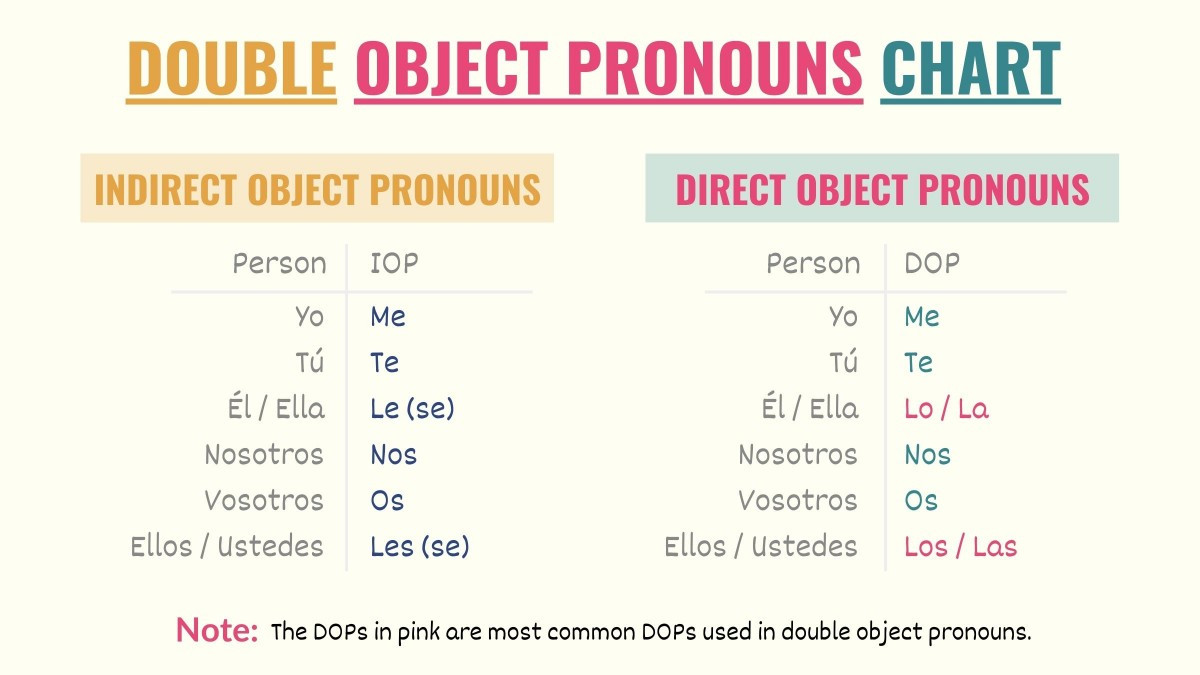Bosque de Palabras
Bosque de Palabras is a text adventure survival game designed to help you learn Spanish vocabulary and grammar while having fun!
In Bosque de Palabras, you're camping️ in the middle of a dark forest, with only a few pieces of food left and a campfire keeping you warm. Every choice you make is important for your survival.
Perfect for: Novice and Intermediate level Spanish learners.
How to Use Direct and Indirect Object Pronouns in Spanish
Gordon Feliz • Updated Jan 20th, 2024


Apprendre en français

Aprender em Português
In this comprehensive guide, we delve into one of the fundamental aspects of Spanish communication: the use of direct and indirect object pronouns. Whether you're a beginner grappling with the basics or an intermediate learner looking to refine your fluency, understanding these pronouns is key. We break down these concepts into digestible parts, offering clear explanations, illustrative examples, and interactive exercises.
Direct Object Pronouns
Spanish Direct Object Pronouns are small words that replace nouns directly affected by the action of the verb in a sentence. Their primary purpose is to avoid repetition and simplify sentences.
List of Spanish Direct Object Pronouns
- me (me)
-
te (you - informal singular)
- lo (him, it - masculine; you - formal masculine singular)
- la (her, it - feminine; you - formal feminine singular)
- nos (us)
- os (you - informal plural)
- los (them - masculine; you - formal masculine plural)
- las (them - feminine; you - formal feminine plural)
Usage in Sentences
-
Identifying the Direct Object: To use a direct object pronoun, first identify the direct object in the sentence — the noun that receives the action directly. For example, in "Compro el libro" (I buy the book), "el libro" is the direct object.
- Replacing the Noun: Replace the direct object with the appropriate pronoun. From the previous example, "el libro" becomes "lo," making the sentence "Lo compro" (I buy it).
Positioning with Verbs
Before Conjugated Verbs: Usually, these pronouns are placed before conjugated verbs. E.g., "Ella lo ve" (She sees him/it).
Attached to Infinitives/Participles: When used with an infinitive or a gerund, they can be attached to the end. E.g., "Voy a comprarlo" (I am going to buy it), "Está viéndolo" (He/She is seeing him/it).
Examples in Context
"Te veo" - I see you (informal singular).
"Nos invitan" - They invite us.
"La escribo" - I write it/her (feminine noun/person).
Special Considerations
Agreement in Gender and Number: The pronoun must agree in gender and number with the noun it replaces. E.g., "los" for masculine plural nouns, "las" for feminine plural nouns.
Changes in Formality and Region: The use of "vosotros" and its corresponding pronoun "os" is mainly in Spain, while in Latin America, the formal second-person plural ("ustedes") is used with "los" or "las" depending on the gender.
Indirect Object Pronouns
Indirect Object Pronouns in Spanish are used to replace nouns that are the recipients of the action. They indicate to whom or for whom the action of the verb is done.
List of Spanish Indirect Object Pronouns
- me (me)
- te (you - informal singular)
- le (him, her, it, you - formal singular)
- nos (us)
- os (you - informal plural, mainly used in Spain)
- les (them, you - formal plural)
Usage in Sentences
-
Identifying the Indirect Object: The first step is identifying the indirect object in a sentence — the person or thing that is the recipient of the action. For example, in "Doy el libro a Juan" (I give the book to Juan), "a Juan" is the indirect object.
-
Replacing the Noun: Replace the indirect object with the appropriate pronoun. In the previous example, "a Juan" can be replaced with "le," making the sentence "Le doy el libro" (I give him the book).
Positioning with Verbs
-
Before Conjugated Verbs: Typically, these pronouns are placed before the conjugated verb. E.g., "Ella le escribe" (She writes to him/her).
- Attached to Infinitives/Participles: When used with an infinitive or a gerund, they can be attached to the end. E.g., "Voy a escribirle" (I am going to write to him/her), "Está escribiéndole" (He/She is writing to him/her).
Examples in Context
"Me habla" - He/She speaks to me.
"Nos ofrecen" - They offer us.
"Te envío" - I send to you (informal singular).
Special Considerations
-
No Gender Distinction: Unlike direct object pronouns, indirect object pronouns do not change according to gender. They change only for number (singular/plural).
- Use of 'Le' and 'Les' in Different Contexts: In many regions, "le" and "les" are used irrespective of gender. However, in some places, "leísmo" (using "le" instead of "lo" or "la" as direct object pronouns for masculine and feminine) is common.
-
Clarifying Ambiguity: Sometimes, especially when the pronoun "le" or "les" could refer to multiple entities, it's clarified with "a él," "a ella," "a usted," etc. For example, "Le doy el libro a él" (I give him the book - emphasizing that it's a male recipient).
Using Direct and Indirect Object Pronouns Together
Indirect object pronoun comes before the direct object pronoun.
Example:
Original: Envío la carta a Juan. (I send the letter to Juan.)
With Pronouns: Se la envío. (I send it to him.)
Note on 'le' and 'les': Change to 'se' when used with 'lo, la, los, las'.
Incorrect: Le lo doy.
Correct: Se lo doy.

Language Learning Exercises
Direct Object Pronouns Exercises
Replace the direct object with the correct pronoun:
Original: Compro las manzanas. (I buy the apples.)
With Pronoun: _________. (I buy them.)
Replace the direct object with the correct pronoun:
Original: Ella lee el libro. (She reads the book.)
With Pronoun: Ella _________. (She reads it.)
Replace the direct object with the correct pronoun:
Original: Escuchamos la música. (We listen to the music.)
With Pronoun: _________. (We listen to it.)
Replace the direct object with the correct pronoun:
Original: Juan ve a los niños. (Juan sees the children.)
With Pronoun: Juan _________. (Juan sees them.)
Replace the direct object with the correct pronoun:
Original: Envías el correo electrónico. (You send the email.)
With Pronoun: _________. (You send it.)
Indirect Object Pronouns Exercises
Replace the indirect object with the correct pronoun:
Original: Doy el regalo a Ana. (I give the gift to Ana.)
With Pronoun: _________. (I give it to her.)
Replace the indirect object with the correct pronoun:
Original: Enviamos la carta a los abuelos. (We send the letter to the grandparents.)
With Pronoun: _________. (We send it to them.)
Replace the indirect object with the correct pronoun:
Original: Él cuenta una historia a ti. (He tells a story to you.)
With Pronoun: Él _________. (He tells you a story.)
Replace the indirect object with the correct pronoun:
Original: Ofreces ayuda a mí. (You offer help to me.)
With Pronoun: _________. (You offer help to me.)
Replace the indirect object with the correct pronoun:
Original: Cocinas la cena para nosotros. (You cook dinner for us.)
With Pronoun: _________. (You cook it for us.)
Direct Object Pronouns Answer Key
Compro las manzanas. (I buy the apples.)
With Pronoun: Las compro. (I buy them.)
Ella lee el libro. (She reads the book.)
With Pronoun: Ella lo lee. (She reads it.)
Escuchamos la música. (We listen to the music.)
With Pronoun: La escuchamos. (We listen to it.)
Juan ve a los niños. (Juan sees the children.)
With Pronoun: Juan los ve. (Juan sees them.)
Envías el correo electrónico. (You send the email.)
With Pronoun: Lo envías. (You send it.)
Indirect Object Pronouns Answer Key
Doy el regalo a Ana. (I give the gift to Ana.)
With Pronoun: Le doy el regalo. (I give it to her.)
Enviamos la carta a los abuelos. (We send the letter to the grandparents.)
With Pronoun: Les enviamos la carta. (We send it to them.)
Él cuenta una historia a ti. (He tells a story to you.)
With Pronoun: Él te cuenta una historia. (He tells you a story.)
Ofreces ayuda a mí. (You offer help to me.)
With Pronoun: Me ofreces ayuda. (You offer help to me.)
Cocinas la cena para nosotros. (You cook dinner for us.)
With Pronoun: Nos cocinas la cena. (You cook it for us.)
Additional Resources To Learn More
Spanish Verbs That Change Meaning When Reflexive: While this article focuses on reflexive verbs and their meanings, it's beneficial for understanding how pronouns in Spanish, including indirect object pronouns, can alter the meaning of verbs. This understanding is crucial for grasping the nuances of Spanish grammar.
Beginner's Guide to Spanish Sentence Structure With Examples: This article provides foundational knowledge on Spanish sentence structure, which is integral to effectively using direct and indirect object pronouns. Understanding the overall structure of Spanish sentences will help learners better place and use these pronouns in context.
Real Fast Spanish - The Definitive Guide to Spanish Direct and Indirect Object Pronouns: This guide offers a comprehensive overview of how to use both direct and indirect object pronouns in Spanish. It includes practical examples and explanations of common mistakes to avoid. Useful for understanding the nuances of using these pronouns in different contexts.
Teacher Catalina - Direct and Indirect Object Pronouns in Spanish: A Complete Guide: This resource provides a detailed breakdown of the different types of object pronouns and their usage in Spanish, including how to decide between similar pronouns like 'lo' and 'le'. It's great for learners who want a thorough understanding of the subject.
Spanish Learning Lab - Indirect Object Pronouns in Spanish: This resource focuses on indirect object pronouns, explaining their use with practical sentences and examples. It's particularly helpful for understanding how indirect object pronouns function in various sentence structures.
